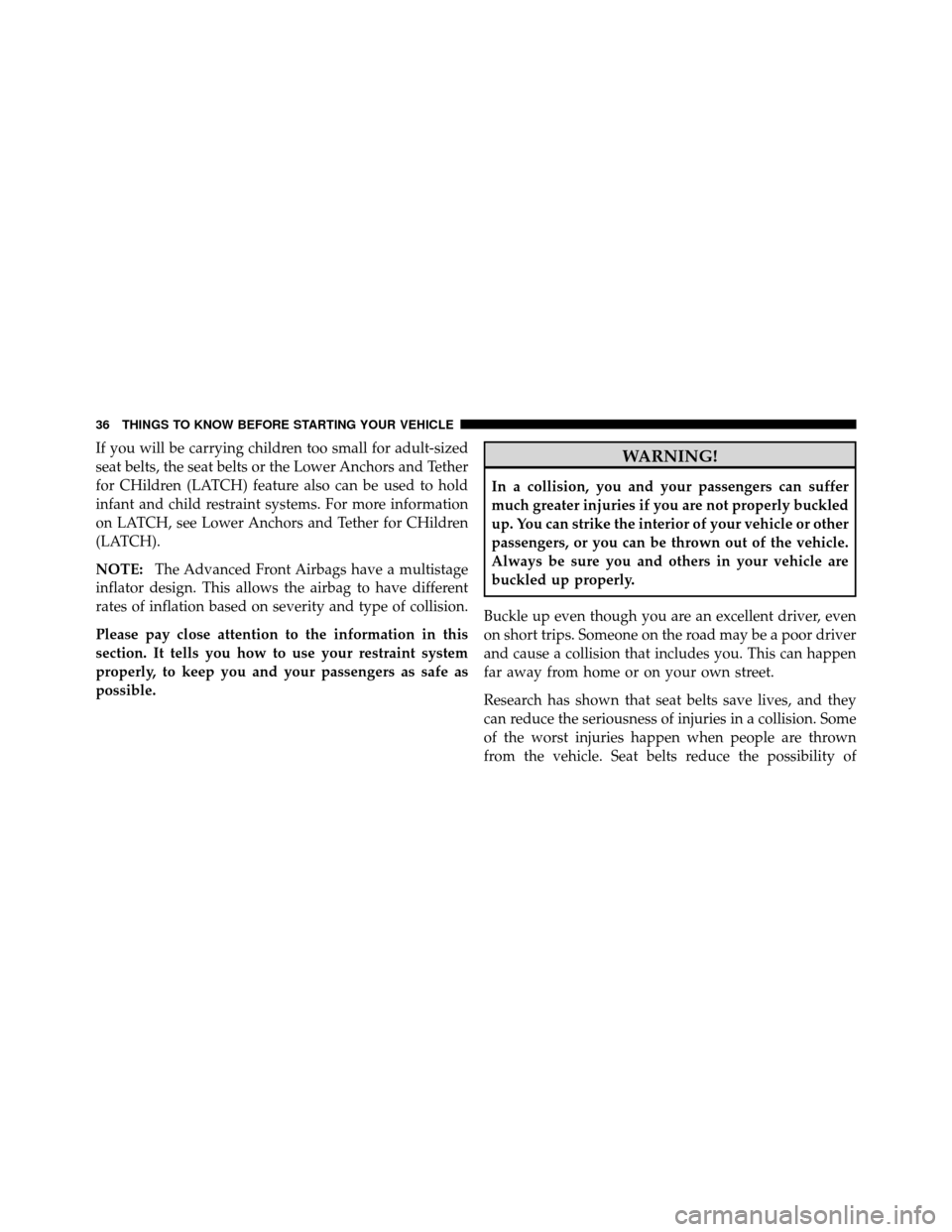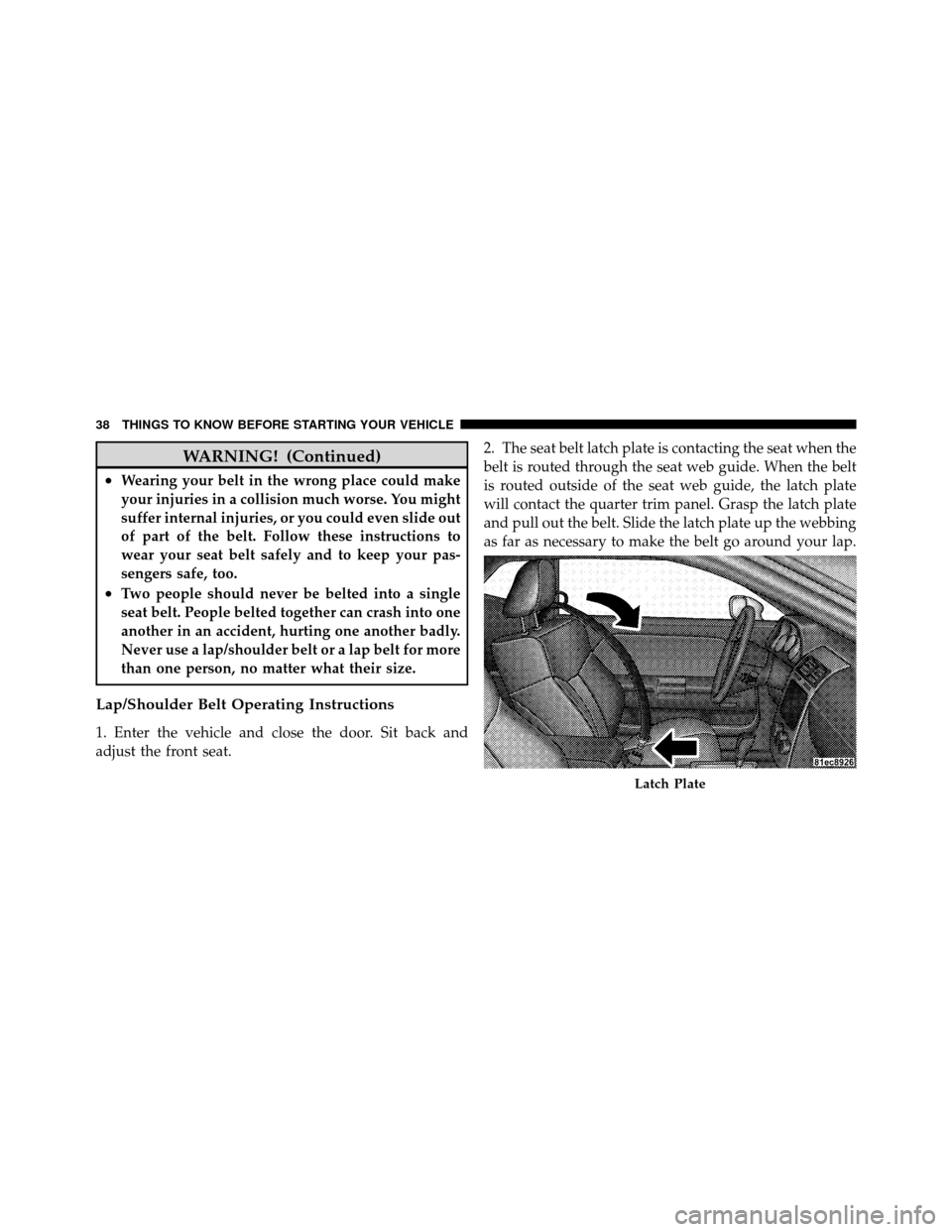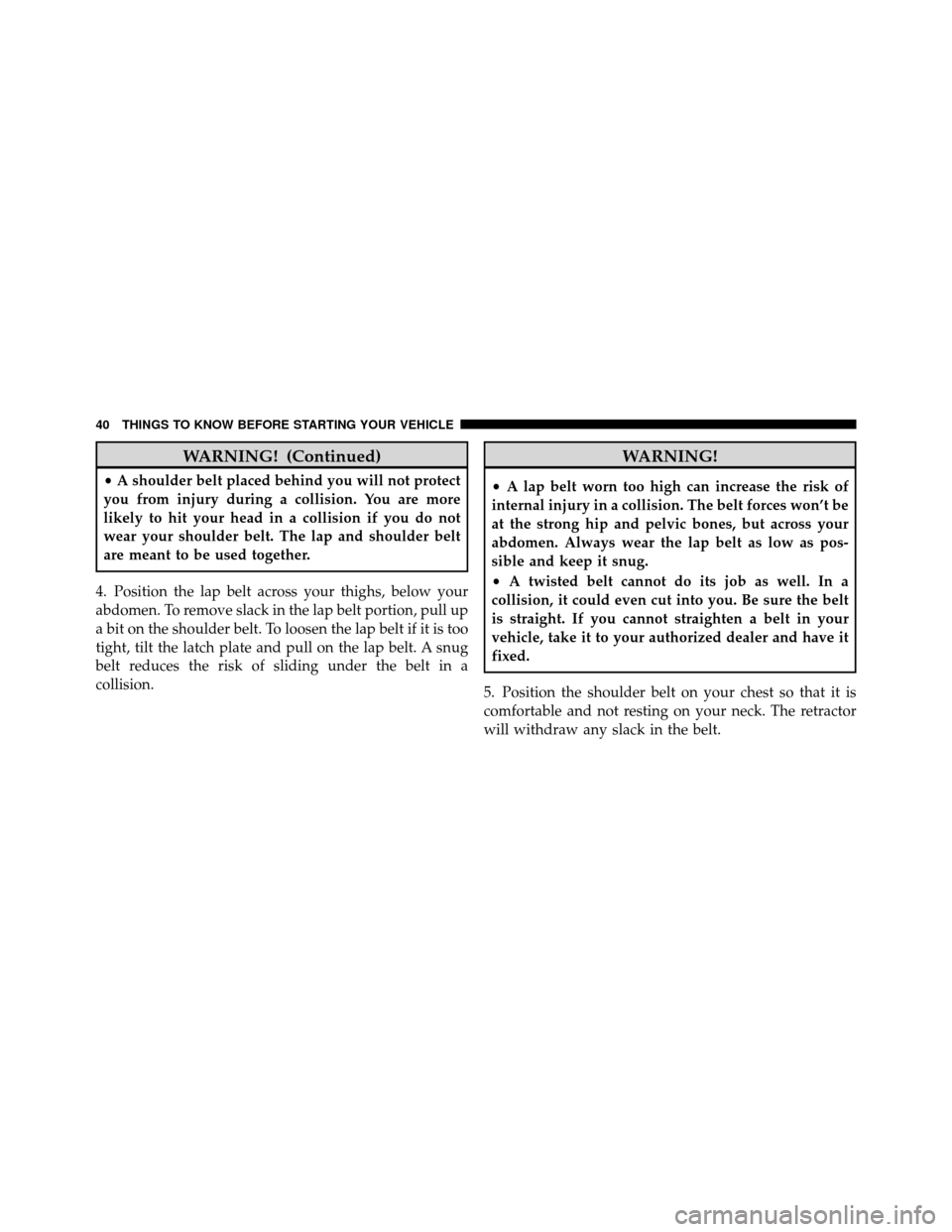Page 11 of 436

▫To Open The Trunk .................... 24
▫ Using The Panic Alarm ................. 24
▫ Programming Additional Transmitters ...... 24
▫ Transmitter Battery Replacement .......... 24
▫ General Information ................... 25
� Remote Starting System .................. 26
▫ How To Use Remote Start ............... 26
� Door Locks ........................... 28
▫ Manual Door Locks ................... 28
▫ Power Door Locks .................... 29
� Windows ............................ 32
▫ Power Windows ...................... 32
▫ Wind Buffeting ....................... 33 �
Trunk Lock And Release ................. 33
� Trunk Safety Warning ................... 34
▫ Trunk Emergency Release ............... 35
� Occupant Restraints ..................... 35
▫ Lap/Shoulder Belts .................... 37
▫ Lap/Shoulder Belt Untwisting Procedure .... 41
▫ Automatic Locking Retractors (ALR)
Mode — If Equipped ................... 42
▫ Seat Belt Pretensioners — If Equipped ...... 43
▫ Enhanced Seat Belt Use Reminder System
(BeltAlert�) ......................... 43
▫ Seat Belts And Pregnant Women .......... 44
▫ Seat Belt Extender ..................... 45
10 THINGS TO KNOW BEFORE STARTING YOUR VEHICLE
Page 36 of 436
Trunk Emergency Release
The trunk of your vehicle is equipped with an emergency
release handle. It is located on the inside of the trunk lid,
near the latch, and is coated so that it glows in a darkened
trunk. Pull on the handle to open the trunk.
OCCUPANT RESTRAINTS
Some of the most important safety features in your
vehicle are the restraint systems:
•Three-point lap and shoulder belts for the driver and
all passengers
•Advanced Front Airbags for driver and front passen-
ger
•Supplemental Side Airbag Inflatable Curtains (SABIC)
for the driver and passengers seated next to a window —
if equipped
•An energy-absorbing steering column and steering
wheel
•Knee bolsters/blockers for front seat occupants
•Front seat belts incorporate pretensioners to enhance
occupant protection by managing occupant energy
during an impact event — if equipped
Emergency Release
2
THINGS TO KNOW BEFORE STARTING YOUR VEHICLE 35
Page 37 of 436

If you will be carrying children too small for adult-sized
seat belts, the seat belts or the Lower Anchors and Tether
for CHildren (LATCH) feature also can be used to hold
infant and child restraint systems. For more information
on LATCH, see Lower Anchors and Tether for CHildren
(LATCH).
NOTE:The Advanced Front Airbags have a multistage
inflator design. This allows the airbag to have different
rates of inflation based on severity and type of collision.
Please pay close attention to the information in this
section. It tells you how to use your restraint system
properly, to keep you and your passengers as safe as
possible.WARNING!
In a collision, you and your passengers can suffer
much greater injuries if you are not properly buckled
up. You can strike the interior of your vehicle or other
passengers, or you can be thrown out of the vehicle.
Always be sure you and others in your vehicle are
buckled up properly.
Buckle up even though you are an excellent driver, even
on short trips. Someone on the road may be a poor driver
and cause a collision that includes you. This can happen
far away from home or on your own street.
Research has shown that seat belts save lives, and they
can reduce the seriousness of injuries in a collision. Some
of the worst injuries happen when people are thrown
from the vehicle. Seat belts reduce the possibility of
36 THINGS TO KNOW BEFORE STARTING YOUR VEHICLE
Page 38 of 436

ejection and the risk of injury caused by striking the
inside of the vehicle.Everyone in a motor vehicle should
be belted at all times.
Lap/Shoulder Belts
All seating positions in your vehicle are equipped with
lap/shoulder belts.
The belt webbing retractor is designed to lock during
very sudden stops or impacts. This feature allows the
shoulder part of the belt to move freely with you under
normal conditions. However, in a collision, the belt will
lock and reduce your risk of striking the inside of the
vehicle or being thrown out.
WARNING!
•It is extremely dangerous to ride in a cargo area,
inside or outside of a vehicle. In a collision, people
riding in these areas are more likely to be seri-
ously injured or killed.
•Do not allow people to ride in any area of your
vehicle that is not equipped with seats and seat
belts.
•Be sure everyone in your vehicle is in a seat and
using a seat belt properly.
•Wearing a seat belt incorrectly is dangerous. Seat
belts are designed to go around the large bones of
your body. These are the strongest parts of your
body and can take the forces of a collision best.
(Continued)
2
THINGS TO KNOW BEFORE STARTING YOUR VEHICLE 37
Page 39 of 436

WARNING! (Continued)
•Wearing your belt in the wrong place could make
your injuries in a collision much worse. You might
suffer internal injuries, or you could even slide out
of part of the belt. Follow these instructions to
wear your seat belt safely and to keep your pas-
sengers safe, too.
•Two people should never be belted into a single
seat belt. People belted together can crash into one
another in an accident, hurting one another badly.
Never use a lap/shoulder belt or a lap belt for more
than one person, no matter what their size.
Lap/Shoulder Belt Operating Instructions
1. Enter the vehicle and close the door. Sit back and
adjust the front seat.2. The seat belt latch plate is contacting the seat when the
belt is routed through the seat web guide. When the belt
is routed outside of the seat web guide, the latch plate
will contact the quarter trim panel. Grasp the latch plate
and pull out the belt. Slide the latch plate up the webbing
as far as necessary to make the belt go around your lap.
Latch Plate
38 THINGS TO KNOW BEFORE STARTING YOUR VEHICLE
Page 40 of 436
3. When the belt is long enough to fit, insert the latch
plate into the buckle until you hear a “click.”WARNING!
•A belt that is buckled into the wrong buckle will
not protect you properly. The lap portion could ride
too high on your body, possibly causing internal
injuries. Always buckle your belt into the buckle
nearest you.
• A belt that is too loose will not protect you as well.
In a sudden stop, you could move too far forward,
increasing the possibility of injury. Wear your seat
belt snug.
• A belt that is worn under your arm is very danger-
ous. Your body could strike the inside surfaces of the
vehicle in a collision, increasing head and neck
injury. A belt worn under the arm can cause internal
injuries. Ribs are not as strong as shoulder bones.
Wear the belt over your shoulder so that your stron-
gest bones will take the force in a collision.
(Continued)
Latch Plate To Buckle
2
THINGS TO KNOW BEFORE STARTING YOUR VEHICLE 39
Page 41 of 436

WARNING! (Continued)
•A shoulder belt placed behind you will not protect
you from injury during a collision. You are more
likely to hit your head in a collision if you do not
wear your shoulder belt. The lap and shoulder belt
are meant to be used together.
4. Position the lap belt across your thighs, below your
abdomen. To remove slack in the lap belt portion, pull up
a bit on the shoulder belt. To loosen the lap belt if it is too
tight, tilt the latch plate and pull on the lap belt. A snug
belt reduces the risk of sliding under the belt in a
collision.
WARNING!
• A lap belt worn too high can increase the risk of
internal injury in a collision. The belt forces won’t be
at the strong hip and pelvic bones, but across your
abdomen. Always wear the lap belt as low as pos-
sible and keep it snug.
• A twisted belt cannot do its job as well. In a
collision, it could even cut into you. Be sure the belt
is straight. If you cannot straighten a belt in your
vehicle, take it to your authorized dealer and have it
fixed.
5. Position the shoulder belt on your chest so that it is
comfortable and not resting on your neck. The retractor
will withdraw any slack in the belt.
40 THINGS TO KNOW BEFORE STARTING YOUR VEHICLE
Page 42 of 436
6. To release the belt, push the red button on the buckle.
The belt will automatically retract to its stowed position.
If necessary, slide the latch plate down the webbing to
allow the belt to retract fully.
WARNING!
A frayed or torn belt could rip apart in a collision and
leave you with no protection. Inspect the belt system
periodically, checking for cuts, frays, or loose parts.
Damaged parts must be replaced immediately. Do
not disassemble or modify the system. Seat belt
assemblies must be replaced after a collision if they
have been damaged (bent retractor, torn webbing,
etc.).
Lap/Shoulder Belt Untwisting Procedure
Use the following procedure to untwist a twisted lap/
shoulder belt.
1. Position the latch plate as close as possible to the
anchor point.Removing Slack From Belt
2
THINGS TO KNOW BEFORE STARTING YOUR VEHICLE 41